Episode #390: How Impactful Is Math Coaching?
LISTEN NOW HERE…
WATCH NOW…
Is your math coaching program truly transforming classroom practice—or just treading water?
Many districts wrestle with whether coaching is worth the investment or how to maximize its impact. If you’ve ever wondered why some schools see real progress while others stall while striving for sustainable math improvement—despite similar coaching setups—this episode unpacks the hidden reasons behind that divide. Whether you’re a district leader, math coach, or teacher leader, this conversation reveals the often-overlooked factors that can make or break your coaching strategy.
In this episode, you’ll discover:
- Why spreading math coaching support thin across many teachers often leads to minimal gains.
- The four critical phases of teacher change—and why math coaching is essential in the final, most powerful stage.
- How restructuring your math coaching model can build momentum and create a ripple effect across your district.
Press play now to rethink your approach to math coaching and unlock deeper, more sustainable impact in your math classrooms.
Attention District Math Leaders:
Not sure what matters most when designing math improvement plans? Take this assessment and get a free customized report: https://makemathmoments.com/grow/
Ready to design your math improvement plan with guidance, support and using structure? Learn how to follow our 4 stage process. https://growyourmathprogram.com
Looking to supplement your curriculum with problem based lessons and units? Make Math Moments Problem Based Lessons & Units
Be Our Next Podcast Guest!
Join as an Interview Guest or on a Mentoring Moment Call
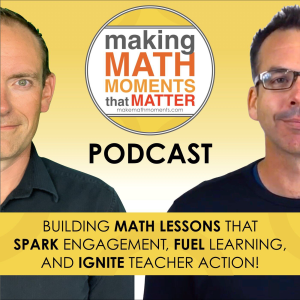
Apply to be a Featured Interview Guest
Book a Mentoring Moment Coaching Call
Are You an Official Math Moment Maker?
FULL TRANSCRIPT
Kyle Pearce: All right there math moment makers. We are going to be talking about a topic that comes up quite a bit when we are working with different districts. And the idea here is about a coaching effective coaching. Do I need coaching that district has coaching this district doesn’t and really today we’re going to talk about like how important coaching really is for your district to make moves forward and
You know what? I think I’m going to give a little teaser here and say that there’s a lot of districts that have coaching in place that may or may not be advancing as far as some of the districts that have no coaching whatsoever are thinking. And today, we’re going to kind of unpack why that might be and maybe some of the things we can do if we don’t have coaching in place. Maybe we don’t have the funding for it.
And then more specifically, what we could be doing and what we can maybe be changing so that the coaching that we do have in place can be more impactful and more effective to help us reach our math goals.
Jon Orr: Yeah, so we’re really answering this question, like how impactful is our coaching program or is a coach in general? You know, like how, how can then, like you’re saying, how can we structure it so that it is more impactful? And that’s, and that’s what we’re going to unpack. Now it’s just Kyle and I today. So if you’ve been a regular listener for the last, it’s been almost a year where you’ve heard three voices on the podcast. One of those voices is Yvette Lehman.
our dynamite math coach here at the Make Math Moments team. She’ll be back, don’t worry. She’ll be here in one of the next episodes. Kyle and I just jumped on this call. She’s tied up in a meeting at this time. So don’t miss out if you’re like, man, I really wanted to hear Yvette’s take on coaching. Maybe we’ll do an episode in the future.
Kyle Pearce: Yeah, leave some comments on YouTube or wherever you’re at. And I know that she’ll be wanting to dig into this discussion as well.
Jon Orr: And I want, yeah. And probably the time this goes live, we should give her a shout out, know? Like we should give Yvette a shout out. This would be like her one year anniversary, you know, working at Make Math Moments, supporting teachers, supporting coaches, supporting districts across North America. So one year full, you know, doing this full-time.
know, work and supporting all these wonderful, wonderful people. give a shout out, I’m giving a shout out to Yvette for her one year anniversary here with our team. All right, so how essential is a coach? And that’s the important idea here. Now, when you think about coachings, we’ve got some stats here we wanna start with because when we think about professional development, whether we have a coach or not, sometimes we start to think about like, what does it take?
You know, this is a common question that we often, you know, we do get asked when we’re working with schools, school districts, when we head out to do presentations across the country, across North America, a very common question is what does it take to create shifts in teachers’ practice? Because, you know, we’ve talked about, you know, the eight effective teaching practices. This is like year 11 that the book, you know, Principles to Actions was published. Like with these…
practices have been around. We know about say different strategies and models that we should be using with our teachers to strengthen the roots of their classroom trees so that they have strong programs. We know all the pieces. We know that there’s a lot of these pieces out there. And I think what we’re thinking about is what does it take to make the shifts? Because this common question is like I…
I think I’ve been trying to make shifts as a coach or a leader or a consultant or a coordinator, but it’s just not gaining traction. And so like, is my coaching or is coaching the right move for us to go? And so let’s roll back some of these statistics that are out there when we think about professional development over the course of a year. There’s a study, a synthesis study done by the National Staff Development Council, and it found that teachers
need, and this is a huge range, Kyle, teachers need 30 to 100 professional development hours over the six to 12 months to successfully adopt inquiry-oriented teaching practices. And so that’s a big range, know, 100 hours on one end and 30 hours on the, the low end. There was another study that kind of reinforces the same idea done by the Learning Policy Institute.
They were coming up with a number themselves. They effective PD programs typically provide around 49 hours per year, which correlates to meaningful gains in teachers’ performance and student outcomes. And so if you start to unpack that, that sounds like a lot.
Kyle Pearce: Yeah, absolutely. Yeah. it is a lot. honestly, though, when you actually think about it, and if you really get rational and you really start to think and analyze how much traction you can gain from, let’s say, one PLC or, let’s say, from even a full day of professional development, right? There’s a lot of, we’ll call it surface scratching that has to take place, right? We have to introduce ideas.
try to get people to sort of understand the why behind new ideas. But then we have to actually get into the math. We talk about doing the math quite a bit. And the reality is, is that in many districts around North America and outside of North America, it is really, really difficult to get the amount of time required, like to dedicate that time in order for this learning to take place. Now,
Some people may remember all the way back when we had Craig Guthrie on and we talked about the Norcan project where, you know, Craig and I and some people from Canada, we went over to Norway and we’re seeing some of the practices that were going on over there. And something I really liked here that I think really can be helpful is that built into teacher schedules in Norway was collaborative planning time. And we have some of that here in North America.
But it was significant, you know, like we’re talking like there was a number of hours there. Now I can’t promise you that they were all being utilized to, you know, the greatest degree of effectiveness or maybe focus or intentionality. That part we don’t really know. I don’t have data on that. But anecdotally, they had the conditions set to at least give the opportunity for us to have that time required.
And the real challenge we have here and you know these numbers are talking about professional development in general. When we introduce coaching into the process the idea of the coach can potentially up the amount of those professional development hours even while teachers are teaching when we do co-teaching when we do these types of things. But this now brings in like the big question mark is how are we utilizing our coaches like when we do have coaching available.
Are we taking those coaches and allowing certain teachers to be able to go really deep and get closer to some of these hours that you were referencing, 49 hours or 30 to a hundred hours or whatever the ranges that you want to use from research. Are we using those coaches in a way that will help more teachers get closer to the level of impact that we’re after or are we taking those coaches and maybe spreading them too thin so that everybody gets some benefit, but in reality, that benefit is so small that we actually don’t see any noticeable or notable changes.
Jon Orr: for for sure. And I think that idea about the impact coaches can actually create actually follows the four phases of teacher adoption or teacher shift, which you alluded to when we think about professional development and the hours that we do dedicate is that we need, the first component there is we need teachers to understand that this is the right move. Teachers have to believe this is the right move to make so that
they can take that next step to say like, what does that look like? Right. So, so that’s usually done in professional development is you try to convince teachers with data, you convince them with emotion, you convince them, you know, with, with, different aspects of, of like, this is, this is either maybe it’s policy and we’re trying to follow policy. So, so usually that is done in professional development sessions. When you, when you think about them, then, then the next component is teachers need to see that move or the, or the practice in action.
And so sometimes that’s modeling, sometimes it’s modeling in your classroom, sometimes that’s modeling in a group setting. Sometimes we’ve seen the professional development just don’t do that very well because they’ll take that approach that teachers are professionals, they don’t need to engage in the actual learning, they don’t need to engage in the actual practice. We’ll tell them about the practice, you’re missing a… Exactly, you’re missing a huge component there because teachers, it helps with the adoption stages when teachers start to feel what it’s like.
Kyle Pearce: Yeah, I don’t want to insult anyone or anything like that.
Jon Orr: and what the practices are like and the emotions are like and what the mathematics feels like, the grappling with the math, like you said. So the third stage is specifically teachers need like time to practice, right? So teachers need to like that, like I’m gonna absorb this new learning, but then I need to like reflect on it. How’s this gonna work with my students? How it’s gonna work in my classroom? How does that work with my agendas and my schedules? How does that fit with me? And so we do need that reflection time. Sometimes that’s built into PD as well.
But then this is where the coaching comes in, right? The fourth stage, which accounts for 90 % of teachers shifts in practice is the continued sustained follow-up support. And that is the part where the coaches play a huge role is if we are, and that’s where it falls in with the hours, if we’re missing those hours. Like if you think about all those PD days you’re rolling out on your numeracy day at the beginning of the year, or maybe you’ve got some spaced out days that we’re pulling teachers together. Like that’s not a ton of those 30,
49 hours that we that are required. So like what you’re saying is that coaching can make up some of those hours and then it’s then it’s what then the whole spreading, you know yourself too thin does come into play like we’ve got a district we supported we actually shifted some of their structures around coaching because of these facts. They were they were sending you know, they they had this like hey, I want to make sure we’re doing the greatest good for the greatest number.
So we’ve got three coaches, we wanna spread them across our schools. Right, everybody’s gonna get some coaching. We don’t wanna leave anybody out. So it’s like, let’s spread some coaches across the districts. But what happened, right, is like you already alluded to this, is you spread thin, but what’s happening is in this district, you’ve got a two-day lesson model and that coach is maybe walking in on that first day, or it could even be the second day because there’s no coordination there. It’s like,
I’m coming on Tuesday. And so then that coach walks in and mostly what was happening from what we’ve observed, what we heard, you know, through the stories and the observations that the consultants were making was that it was like, I’m here to help, you know, and I’m going to, I’m going to be your extra set of hands. Or, and then maybe there’s an opportunity for us to talk about some practices or, some plucking of pebbles from shoes.
Kyle Pearce: Hmm. Yeah, you also see things like pulling kids in small groups or doing some, like, essentially some tutoring or some remediation or tier two or tier three. at the end of the day, it’s like, that does not make you a coach. Your title might be coach, but the actions in the classroom are not coach moves in order to help us get there, right?
Jon Orr: Totally, totally. so that spreading, so what they were doing is they were kind of spreading themselves too thin across the district because they were coming in, they were doing one day, and then I think there was a two week gap. So it was like they came in one day and then there was like, they weren’t gonna go back to that school for two weeks past. And so you can see that, like what kind of impact are we helping with that teacher? Because it’s likely not focused.
it’s likely not aligned to the school improvement goals or even the district’s vision for mathematics or the objectives that the districts are working on because there isn’t that consistency that’s happening there. The coach is coming in and it’s like out and then they don’t see them for a while and so all of a sudden you’re spreading yourselves across the schools but we’ve got like this surface level touch points which means like there’s touch points there but was it coordinated to…
So the large pullout that you did at the beginning of the year, the middle of the year, is it coordinated to any sort of collaborative groups that are happening? Like, this isn’t a part of how this team’s restructured. They started to do less schools. And so we said, like, it’s more impactful over the long term to do less schools, less teachers initially, with the idea of compounding effect happening. Because if you can…
touch, especially if you’ve got a two day lesson model where day one where you’re doing your, you know, your inquiry and then you were, you were, building upon the learning goals. And then all of sudden day two, you’re like a math talk and then following up with some purposeful practice and tying that together. Like that two day lesson model couldn’t be reinforced in the old strategy, but now all of a sudden they’re going to do a two day lesson model where the coach is there back to back follows the lesson through and then recycles back.
you know, a few days later or a week later, and then that consistency. So it’s like we’re touching less schools, less teachers, but giving more teachers more touch points, accounting for some of those leftover hours that we needed to, in a way, to fill, which I don’t really like saying fill some hours because we wanna make sure that they’re impactful. But when they started to make those shifts, then they started to see that consistency happening, the relationship started to build. All of a sudden this compounding, yeah.
And where we get around the whole, like, what about everybody else? Is what’s happening, and we’ve talked about this on past episodes before, is when you think about giving repeated follow-up support to a teacher, that that teacher, compared to your old model, is getting years of professional development all in one year. Comparatively, comparatively, right? So which means like,
Kyle Pearce: Comparatively, yeah, yeah, to the old model for sure.
Jon Orr: So when you think about it, I sometimes think it’s like, if you said, work with that teacher repeatedly, but they were gonna make a shift from here to here, it’s like think about spectrum of change. It’s like they went from here to here. And if you were gonna work with them this year to make that change, and by the end of the year, they made that change, was it worth it? Right? And because it’s worth it, because everyone’s gonna say, it’s worth it to make a change.
for one teacher, is it worth it to make a change for this one teacher? Sure, because in the old model you weren’t changing anyone. And so we made changes on one teacher and guess what? Now next year you’ve got a co-leader. You’ve got another teacher who exemplifies say the high quality instruction you’re trying to shift across the district or shift your school. And then you can then say that person needs some support but now I’m gonna dedicate some support over to this person.
and then we give intensive support to that. Now all of a sudden we have two. So we’re like, it takes a long time. Like, of course it takes a long time, but it was gonna be infinite amount of time on the old system. So you’re building compound, all of a sudden you got a team, you got an army that’s gonna be eventually there, which you’re helping to solve the sustainability. You’re helping to build your program so that eventually someone’s gonna replace you as a consultant or coordinator. And you want these people who have had this intensive support to be the ones to do it.
Kyle Pearce: You know, like everything you’re saying here makes a hundred percent rational sense. And I think the part in the challenge that we have is that even after, know, you can kind of map that out and you see, and then the problem is, is we’re so impatient as human beings in general, but also in a, get it, I get it. It’s a, you know, superintendents, directors, they are making decisions and they have to go and they have to.
you know, explain their their structures and why they did what they did to trustees and the public and parents and all kinds of things. And this can be incredibly difficult to actually own the reality, right? It’s so much easier to sort of pretend as though us doing the the spread too thin model is actually going to have impact.
And oftentimes I think it comes down to just general ignorance, right? And it’s not ignorance in a bad way. It’s just ignorance that, you know, do the trustees understand that, you know, spreading too thin is actually not going to have an impact, right? Here’s the other aspect. If we do change this model and we do bring the data to the forefront and we say, here, we’re gonna go deeper with less people and try to build this and really try to compound.
the informal leaders in our district, Yvette uses that term quite a bit, where it’s like, really what you’re doing is you’re selecting a handful of individual teachers. Here’s the thing, you can use so many different models to decide on the grouping, right? Is it grade-based? Is it once they hit a certain point in their career, like with a five-year teacher is the one you’re after, or we’re not going to pick.
you know, 30 year teachers. Why? Not because they couldn’t use the support, but because we know that they’re potentially going to be retiring in a few years. So we’re going to, you know, we’re going to design who we select very, very intentionally and start building from there. But it is hard because then now we have to explain ourselves. Why are we changing things and why are we focusing on less teachers? Doesn’t that mean that we’re supporting less and fewer and that means less kids are going to have impact?
This is hard work and sometimes it can be hard to try to justify and bring the data to the table because then you might even get some questions like, well, why weren’t you following the data five years ago? Right. These are very, very difficult things to work with. But at the core of it comes down to how important is it to us, to our team, to our system, to our district, to our school, whatever level you’re at in order to actually make real change.
And the more important it is, the more willing we should be to get vulnerable and make these changes so that we can actually do impactful work, even if it means less having an impact, but sooner, right? And that’s gonna be really the key piece here.
Jon Orr: Right. One of the things I think we, we tried to help our teams, that we support all year, with is, is realizing that that work, the coaching work because of the dedication, the continued follow-up, because it follows say that four stages of adoption follows the hours required for shifting. Like it is the most impactful work I think you could do with.
with where you’re trying to go with your math program. And if you’re trying to make shifts in instruction in your math program across the district, and if that’s the most impactful work you can do, your question is, how can I do the most of my time spent there? And it doesn’t have to be just you. Sometimes when we support a team, it’s just the math coordinator. They don’t have coaches. So some of the questions we ask them is to say,
Okay, if you know that that level of support is impactful, and we know you can’t do it for everyone, and you know we don’t have infinite amount of time, so how much time can you attribute to that most impactful type of work? Because you got all these fires you gotta put out, but it’s like that whole like put your rocks in the jar first, right? Like don’t put the sand in first, put the rocks in first, because the rocks won’t fit if you put the sand in first. So if that’s the most impactful,
how much of that time and how many teachers can you commit to, to creating that change and that supporting and supporting shifts across your one school or two school or one teacher or two teachers this year. Cause if you can say like, I’m committed to doing that, but I can really only commit to supporting once, you know, two times a week in this classroom over the course of this time. Like I feel like I can cover the ground with only two teachers this year.
then commit to the two teachers and then do the other things, but commit to that level of involvement, because everybody still needs that whole like, what are we gonna do on our new Mercy Day with everybody? That still needs to get done. That still needs to be coordinated with what’s happening in the classrooms. But we just encourage them to say, what level of commitment can you make there? Or how do you help the coach, if you have coaches, how do you help those coaches recommit to helping those teachers?
on that journey with, say, doubling down on giving more support to a select few. So it’s just questions you want to ask yourselves to say, if that’s the most important work, how much can you do? Not just, I can’t do it, just how much could you do? If you’re like, I can only get in there once a week for one teacher, commit to it. It’s mostly impactful. So, because you can get to the end of the year and say, I made shifts in that one teacher, is way better than saying, I didn’t make shifts across anyone this year.
Kyle Pearce: 100 % really comes down. You know, the key piece here is like really getting, getting real on what is realistic, like what is possible under the restraints, the constraints that you might have could be budget time. could be, you know, just human capital in general, do that, give it some thought and really you’ve got to get real with yourself so that you can actually see some movement.
And you’re not disappointed that, you know, you set these really lofty goals with, you know, the really no chance of reaching them under the certain circumstances. Right. So do the best that you can within the system. And then if that’s not enough for you, then you can start thinking as well as like, how do we do it differently as we move forward? Right. What is that next step? So great conversation here, friends, if you have not yet head over to the website, make math moments.com.
forward slash district if you’d like to take our district assessment. Now, if you are a classroom teacher, you can add to the same page and just select a classroom teacher and you can figure out where your math classroom or district tree is strong and some of the areas that you might want to focus on next. Today we’re talking coaching. Maybe that assessment’s going to highlight that area or maybe it’s going to highlight some other area of the math classroom tree and you’ll get some next steps as well.
Jon Orr: And if you want to chat with us, we often talk about different coaching structures, different professional development planning strategies. We do this with a handful of leaders and educators every single day. Reach out to us. We’d be glad to chat about these types of structures to best support you and the work that you’re trying to do in your school or your school district. So head on over to makemathmoments.com forward slash discovery. MakeMathMoments.com, four slash discovery. And we might be chatting about your structures soon.
Thanks For Listening
- Book a Math Mentoring Moment
- Apply to be a Featured Interview Guest
- Leave a note in the comment section below.
- Share this show on Twitter, or Facebook.
To help out the show:
- Leave an honest review on iTunes. Your ratings and reviews really help and we read each one.
- Subscribe on iTunes, Google Play, and Spotify.
DOWNLOAD THE 3 ACT MATH TASK TIP SHEET SO THEY RUN WITHOUT A HITCH!
Download the 2-page printable 3 Act Math Tip Sheet to ensure that you have the best start to your journey using 3 Act math Tasks to spark curiosity and fuel sense making in your math classroom!
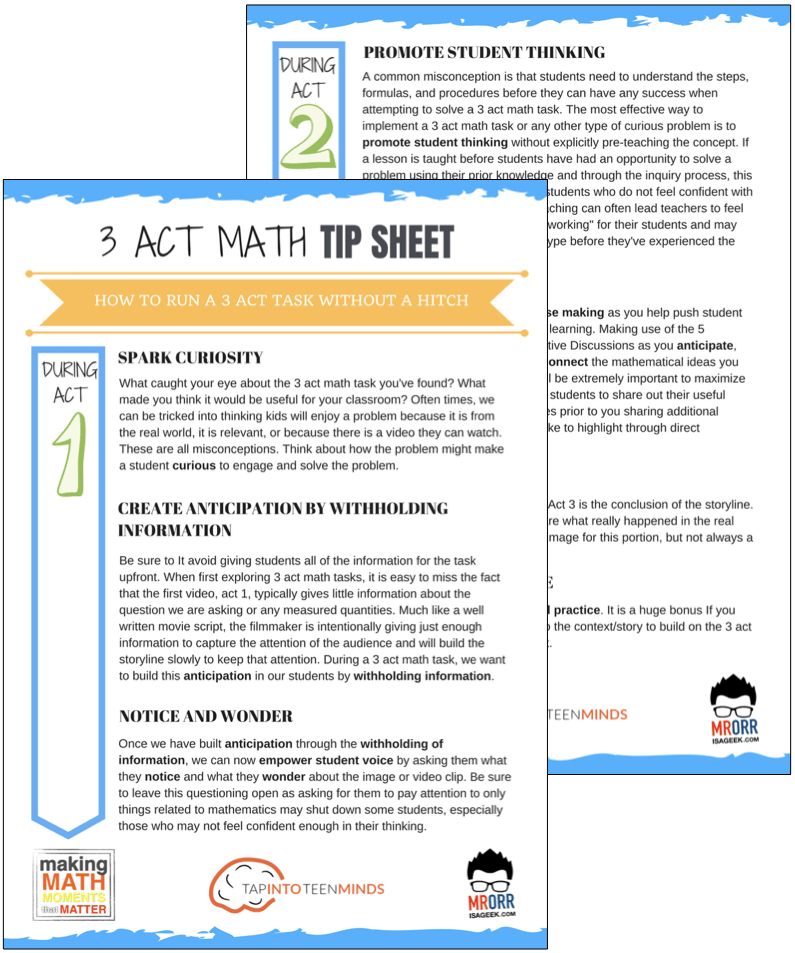
LESSONS TO MAKE MATH MOMENTS
Each lesson consists of:
Each Make Math Moments Problem Based Lesson consists of a Teacher Guide to lead you step-by-step through the planning process to ensure your lesson runs without a hitch!
Each Teacher Guide consists of:
- Intentionality of the lesson;
- A step-by-step walk through of each phase of the lesson;
- Visuals, animations, and videos unpacking big ideas, strategies, and models we intend to emerge during the lesson;
- Sample student approaches to assist in anticipating what your students might do;
- Resources and downloads including Keynote, Powerpoint, Media Files, and Teacher Guide printable PDF; and,
- Much more!
Each Make Math Moments Problem Based Lesson begins with a story, visual, video, or other method to Spark Curiosity through context.
Students will often Notice and Wonder before making an estimate to draw them in and invest in the problem.
After student voice has been heard and acknowledged, we will set students off on a Productive Struggle via a prompt related to the Spark context.
These prompts are given each lesson with the following conditions:
- No calculators are to be used; and,
- Students are to focus on how they can convince their math community that their solution is valid.
Students are left to engage in a productive struggle as the facilitator circulates to observe and engage in conversation as a means of assessing formatively.
The facilitator is instructed through the Teacher Guide on what specific strategies and models could be used to make connections and consolidate the learning from the lesson.
Often times, animations and walk through videos are provided in the Teacher Guide to assist with planning and delivering the consolidation.
A review image, video, or animation is provided as a conclusion to the task from the lesson.
While this might feel like a natural ending to the context students have been exploring, it is just the beginning as we look to leverage this context via extensions and additional lessons to dig deeper.
At the end of each lesson, consolidation prompts and/or extensions are crafted for students to purposefully practice and demonstrate their current understanding.
Facilitators are encouraged to collect these consolidation prompts as a means to engage in the assessment process and inform next moves for instruction.
In multi-day units of study, Math Talks are crafted to help build on the thinking from the previous day and build towards the next step in the developmental progression of the concept(s) we are exploring.
Each Math Talk is constructed as a string of related problems that build with intentionality to emerge specific big ideas, strategies, and mathematical models.
Make Math Moments Problem Based Lessons and Day 1 Teacher Guides are openly available for you to leverage and use with your students without becoming a Make Math Moments Academy Member.
Use our OPEN ACCESS multi-day problem based units!
Make Math Moments Problem Based Lessons and Day 1 Teacher Guides are openly available for you to leverage and use with your students without becoming a Make Math Moments Academy Member.
Partitive Division Resulting in a Fraction
Equivalence and Algebraic Substitution
Represent Categorical Data & Explore Mean
Downloadable resources including blackline masters, handouts, printable Tips Sheets, slide shows, and media files do require a Make Math Moments Academy Membership.
ONLINE WORKSHOP REGISTRATION
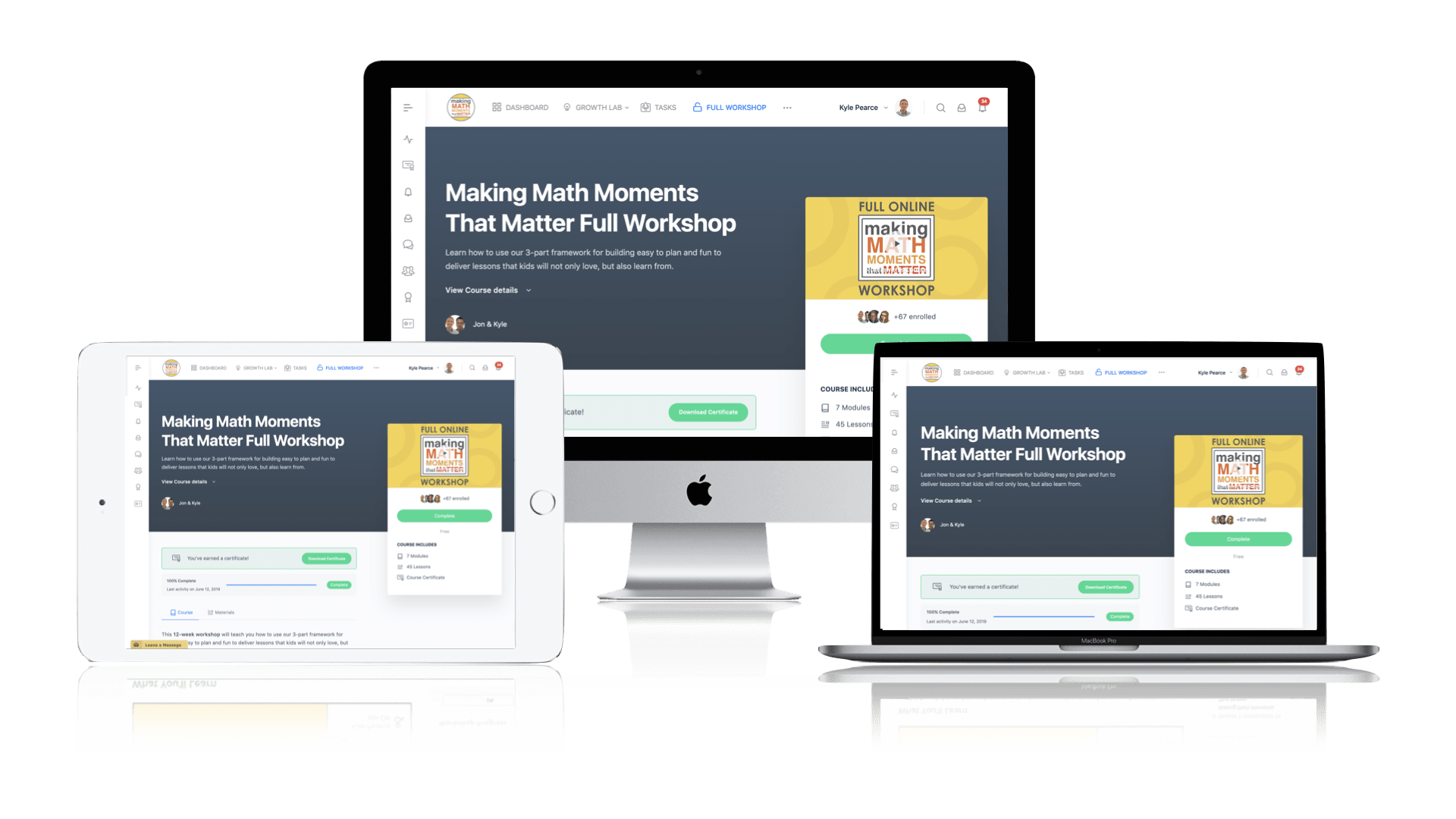
Pedagogically aligned for teachers of K through Grade 12 with content specific examples from Grades 3 through Grade 10.
In our self-paced, 12-week Online Workshop, you'll learn how to craft new and transform your current lessons to Spark Curiosity, Fuel Sense Making, and Ignite Your Teacher Moves to promote resilient problem solvers.
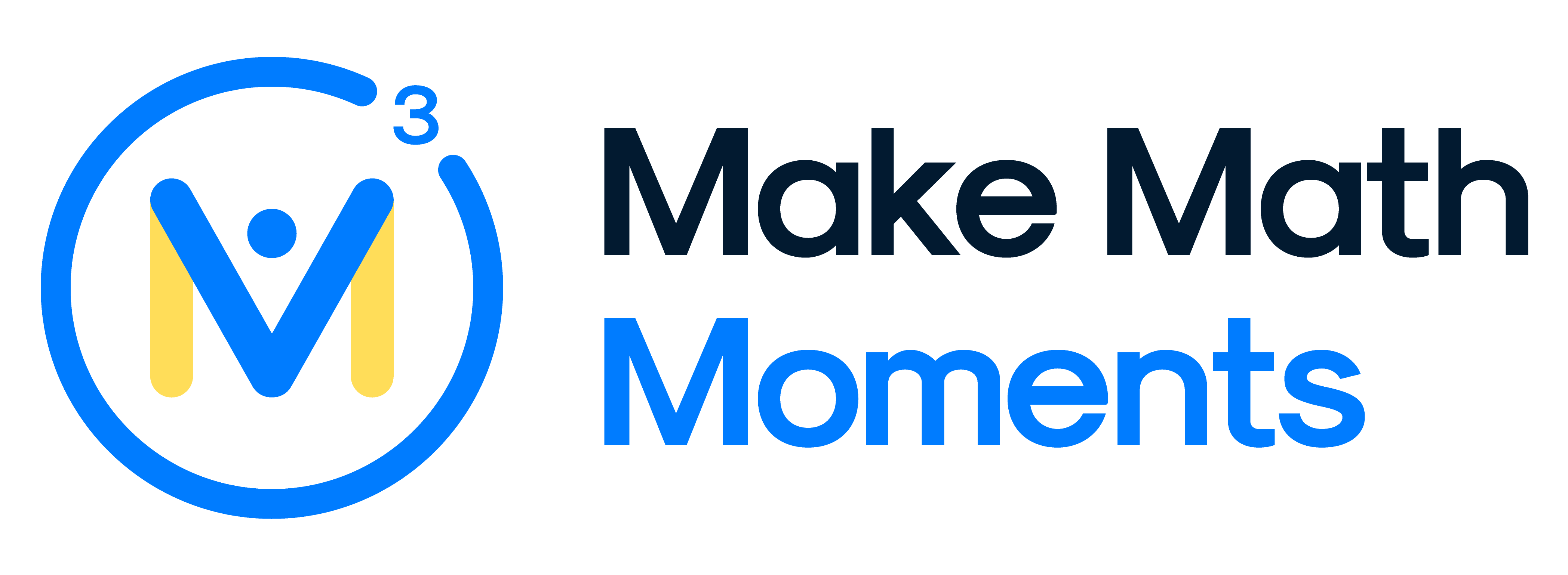



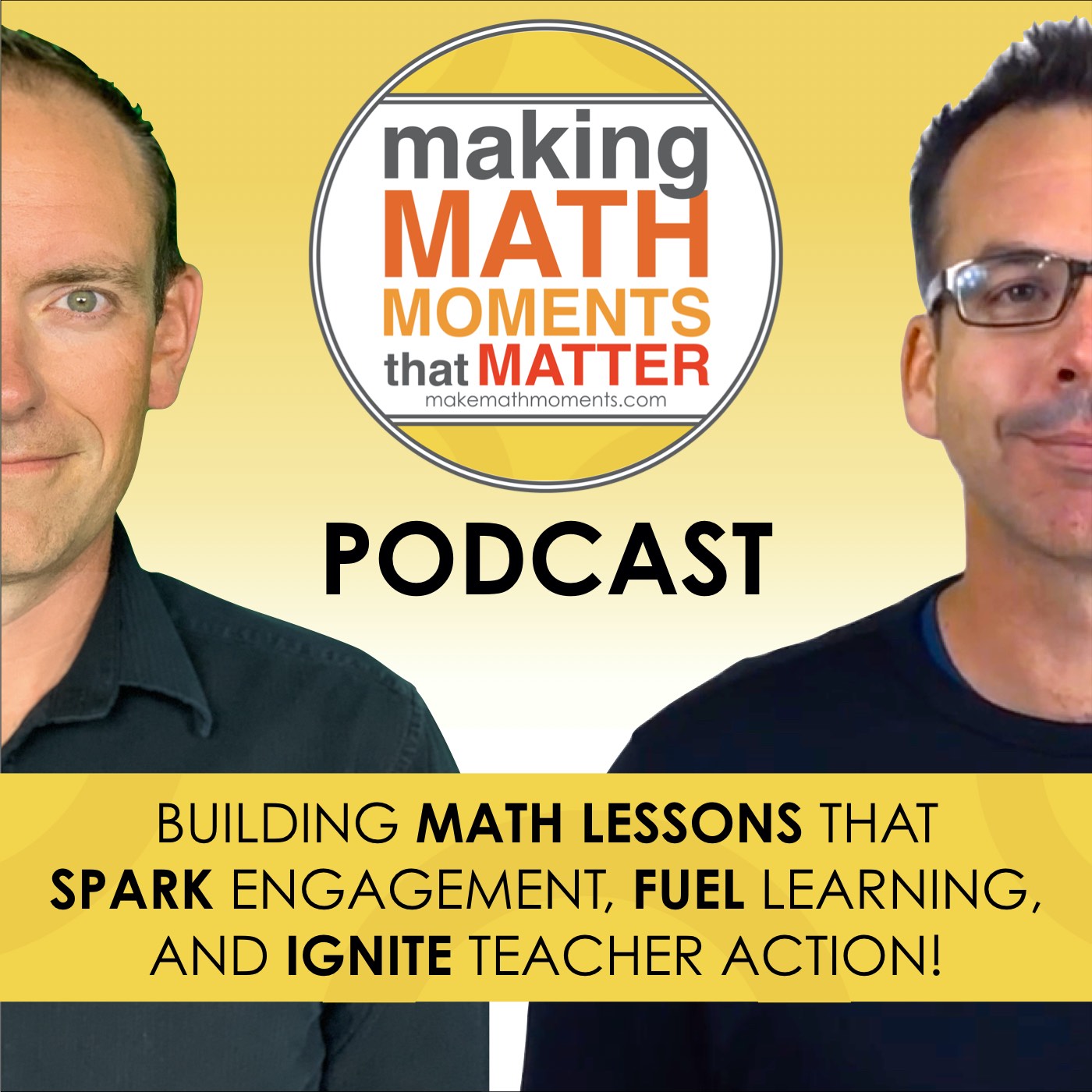
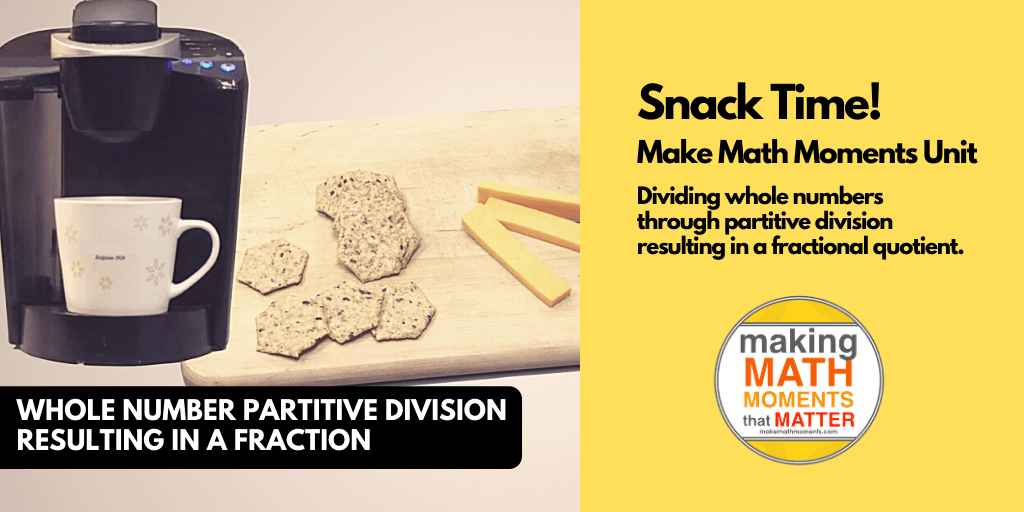
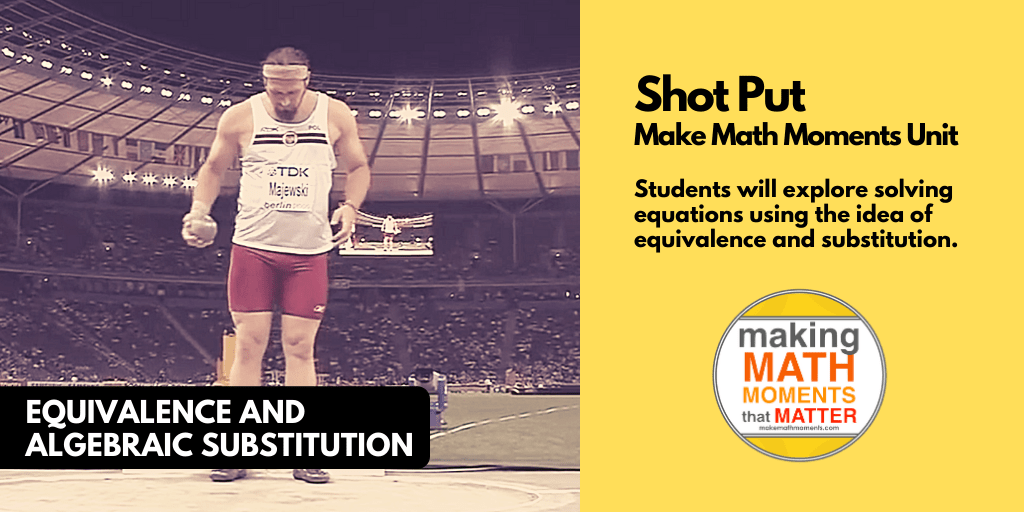
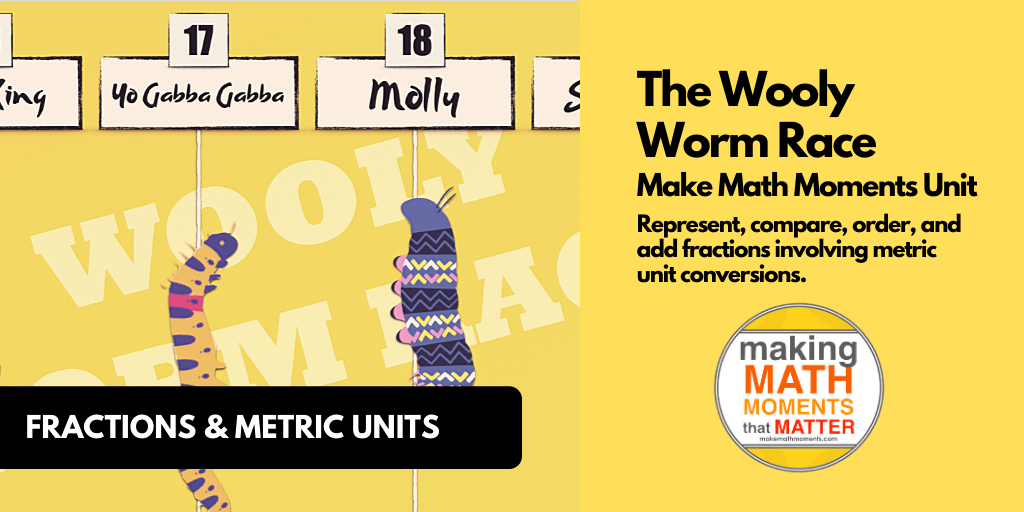
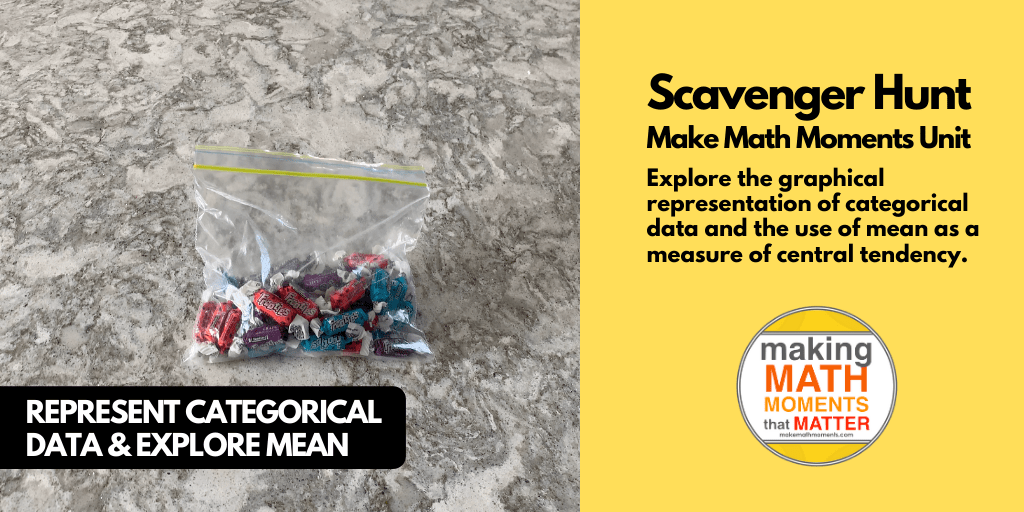
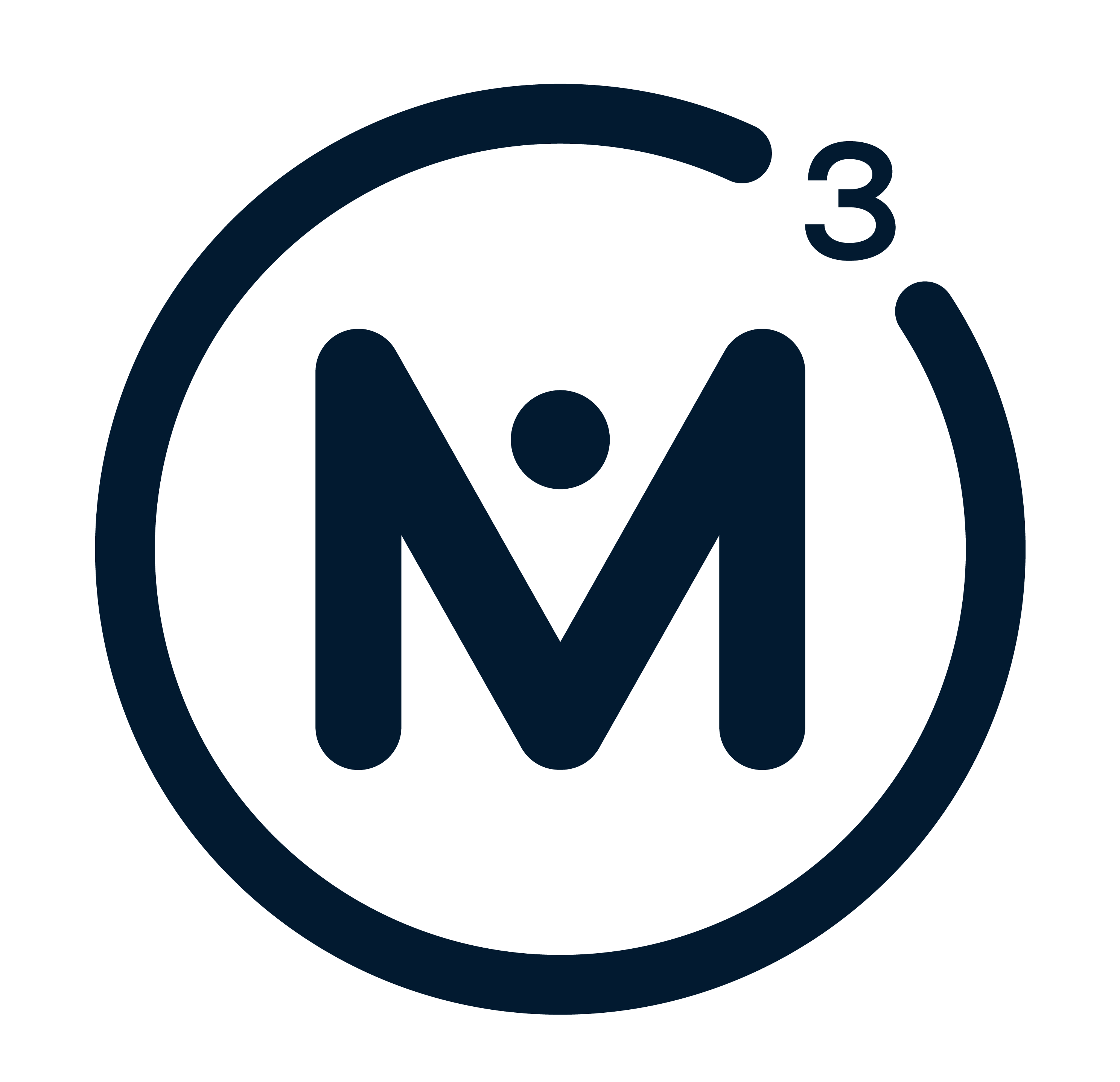
0 Comments